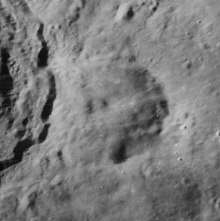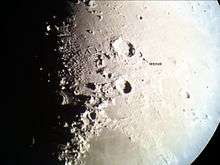Mitchell (crater)
Mitchell is a lunar impact crater, which is attached to the eastern rim of the larger and more prominent crater Aristoteles. It was named after American astronomer Maria Mitchell.[1] The floor of Mitchell is rough and irregular, with a low central rise, being partially filled with the ejecta of the younger Aristoteles. There is a slight notch in the southern rim, and the western wall has been completely absorbed by the rim of Aristoteles.
 Lunar Orbiter 4 image of Mitchell, with rim of Aristoteles at left | |
| Coordinates | 49.7°N 20.2°E |
|---|---|
| Diameter | 30 km |
| Depth | 1.3 km |
| Colongitude | 340° at sunrise |
| Eponym | Maria Mitchell |

Location of the lunar crater Mitchell
Satellite craters
By convention these features are identified on lunar maps by placing the letter on the side of the crater midpoint which is closest to Mitchell.
| Feature | Latitude | Longitude | Diameter | Ref |
|---|---|---|---|---|
| Mitchell B | 48.3° N | 19.3° E | 5.4 km | WGPSN |
| Mitchell E | 47.6° N | 21.7° E | 7.72 km | WGPSN |
gollark: * manga
gollark: * magna
gollark: * magna
gollark: brb, going to spoil a mangma
gollark: I mostly don't *do* anything, so don't worry.
See also
- 1455 Mitchella, asteroid
- Maria Mitchell Observatory
References
- "Mitchell (crater)". Gazetteer of Planetary Nomenclature. USGS Astrogeology Research Program.
- Andersson, L. E.; Whitaker, E. A. (1982). NASA Catalogue of Lunar Nomenclature. NASA RP-1097.CS1 maint: ref=harv (link)
- Bussey, B.; Spudis, P. (2004). The Clementine Atlas of the Moon. New York: Cambridge University Press. ISBN 978-0-521-81528-4.CS1 maint: ref=harv (link)
- Cocks, Elijah E.; Cocks, Josiah C. (1995). Who's Who on the Moon: A Biographical Dictionary of Lunar Nomenclature. Tudor Publishers. ISBN 978-0-936389-27-1.CS1 maint: ref=harv (link)
- McDowell, Jonathan (July 15, 2007). "Lunar Nomenclature". Jonathan's Space Report. Retrieved 2007-10-24.CS1 maint: ref=harv (link)
- Menzel, D. H.; Minnaert, M.; Levin, B.; Dollfus, A.; Bell, B. (1971). "Report on Lunar Nomenclature by the Working Group of Commission 17 of the IAU". Space Science Reviews. 12 (2): 136–186. Bibcode:1971SSRv...12..136M. doi:10.1007/BF00171763.CS1 maint: ref=harv (link)
- Moore, Patrick (2001). On the Moon. Sterling Publishing Co. ISBN 978-0-304-35469-6.CS1 maint: ref=harv (link)
- Price, Fred W. (1988). The Moon Observer's Handbook. Cambridge University Press. ISBN 978-0-521-33500-3.CS1 maint: ref=harv (link)
- Rükl, Antonín (1990). Atlas of the Moon. Kalmbach Books. ISBN 978-0-913135-17-4.CS1 maint: ref=harv (link)
- Webb, Rev. T. W. (1962). Celestial Objects for Common Telescopes (6th revised ed.). Dover. ISBN 978-0-486-20917-3.CS1 maint: ref=harv (link)
- Whitaker, Ewen A. (1999). Mapping and Naming the Moon. Cambridge University Press. ISBN 978-0-521-62248-6.CS1 maint: ref=harv (link)
- Wlasuk, Peter T. (2000). Observing the Moon. Springer. ISBN 978-1-85233-193-1.CS1 maint: ref=harv (link)
External links
| Wikimedia Commons has media related to Mitchell (crater). |
- Wood, Chuck (September 11, 2007). "Eating a Smaller Fry". Lunar Photo of the Day. Archived from the original on June 30, 2015. Retrieved 2007-09-11.
This article is issued from Wikipedia. The text is licensed under Creative Commons - Attribution - Sharealike. Additional terms may apply for the media files.